Identification of key genes and therapeutic drugs for cocaine addiction using integrated bioinformatics analysis
- PMID: 37469839
- PMCID: PMC10352680
- DOI: 10.3389/fnins.2023.1201897
Identification of key genes and therapeutic drugs for cocaine addiction using integrated bioinformatics analysis
Abstract
Introduction: Cocaine is a highly addictive drug that is abused due to its excitatory effect on the central nervous system. It is critical to reveal the mechanisms of cocaine addiction and identify key genes that play an important role in addiction.
Methods: In this study, we proposed a centrality algorithm integration strategy to identify key genes in a protein-protein interaction (PPI) network constructed by deferential genes from cocaine addiction-related datasets. In order to investigate potential therapeutic drugs for cocaine addiction, a network of targeted relationships between nervous system drugs and key genes was established.
Results: Four key genes (JUN, FOS, EGR1, and IL6) were identified and well validated using CTD database correlation analysis, text mining, independent dataset analysis, and enrichment analysis methods, and they might serve as biomarkers of cocaine addiction. A total of seventeen drugs have been identified from the network of targeted relationships between nervous system drugs and key genes, of which five (disulfiram, cannabidiol, dextroamphetamine, diazepam, and melatonin) have been shown in the literature to play a role in the treatment of cocaine addiction.
Discussion: This study identified key genes and potential therapeutic drugs for cocaine addiction, which provided new ideas for the research of the mechanism of cocaine addiction.
Keywords: PPI network; biomarker; centrality algorithm; cocaine addiction; key genes.
Copyright © 2023 Wang, Sun, Chen, Yun, Zhang, Wang, Wu, Lv, He, Li and Chen.
Conflict of interest statement
The authors declare that the research was conducted in the absence of any commercial or financial relationships that could be construed as a potential conflict of interest.
Figures
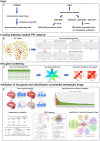

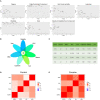



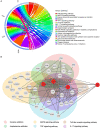
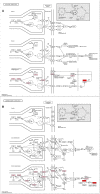

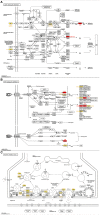
Similar articles
-
Identification of miRNA-mediated gene regulatory networks in L-methionine exposure counteracts cocaine-conditioned place preference in mice.Front Genet. 2023 Jan 19;13:1076156. doi: 10.3389/fgene.2022.1076156. eCollection 2022. Front Genet. 2023. PMID: 36744178 Free PMC article.
-
Bioinformatics-integrated screening of systemic sclerosis-specific expressed markers to identify therapeutic targets.Front Immunol. 2023 Mar 30;14:1125183. doi: 10.3389/fimmu.2023.1125183. eCollection 2023. Front Immunol. 2023. PMID: 37063926 Free PMC article.
-
Construction of miRNA-mRNA network for the identification of key biological markers and their associated pathways in IgA nephropathy by employing the integrated bioinformatics analysis.Saudi J Biol Sci. 2021 Sep;28(9):4938-4945. doi: 10.1016/j.sjbs.2021.06.079. Epub 2021 Jul 1. Saudi J Biol Sci. 2021. PMID: 34466069 Free PMC article.
-
Cannabidiol Treatment Might Promote Resilience to Cocaine and Methamphetamine Use Disorders: A Review of Possible Mechanisms.Molecules. 2019 Jul 16;24(14):2583. doi: 10.3390/molecules24142583. Molecules. 2019. PMID: 31315244 Free PMC article. Review.
-
New perspectives on cocaine addiction: recent findings from animal research.Can J Physiol Pharmacol. 1989 Sep;67(9):1158-67. doi: 10.1139/y89-185. Can J Physiol Pharmacol. 1989. PMID: 2688864 Review.
Cited by
-
DARG: An integrated knowledge base for analyzing addictive drug-related genes.Genes Dis. 2024 Jun 28;12(2):101369. doi: 10.1016/j.gendis.2024.101369. eCollection 2025 Mar. Genes Dis. 2024. PMID: 39669549 Free PMC article. No abstract available.
-
Peroxisome, neuropeptide, and inflammation signaling pathways uniquely impacted by opioid exposure in the hypothalamus of males and females.Mol Cell Neurosci. 2025 May 30;134:104014. doi: 10.1016/j.mcn.2025.104014. Online ahead of print. Mol Cell Neurosci. 2025. PMID: 40451405 Free PMC article.
-
Candidate Key Proteins of Tinnitus in the Auditory and Motor Systems of the Thalamus.Int J Mol Sci. 2025 Jun 17;26(12):5804. doi: 10.3390/ijms26125804. Int J Mol Sci. 2025. PMID: 40565265 Free PMC article.
-
Multiscale topology in interactomic network: from transcriptome to antiaddiction drug repurposing.Brief Bioinform. 2024 Jan 22;25(2):bbae054. doi: 10.1093/bib/bbae054. Brief Bioinform. 2024. PMID: 38499497 Free PMC article.
References
-
- Brown K. T., Levis S. C., O'Neill C. E., Northcutt A. L., Fabisiak T. J., Watkins L. R., et al. . (2018). Innate immune signaling in the ventral tegmental area contributes to drug-primed reinstatement of cocaine seeking. Brain Behav. Immun. 67, 130–138. 10.1016/j.bbi.2017.08.012 - DOI - PMC - PubMed
LinkOut - more resources
Full Text Sources
Miscellaneous

